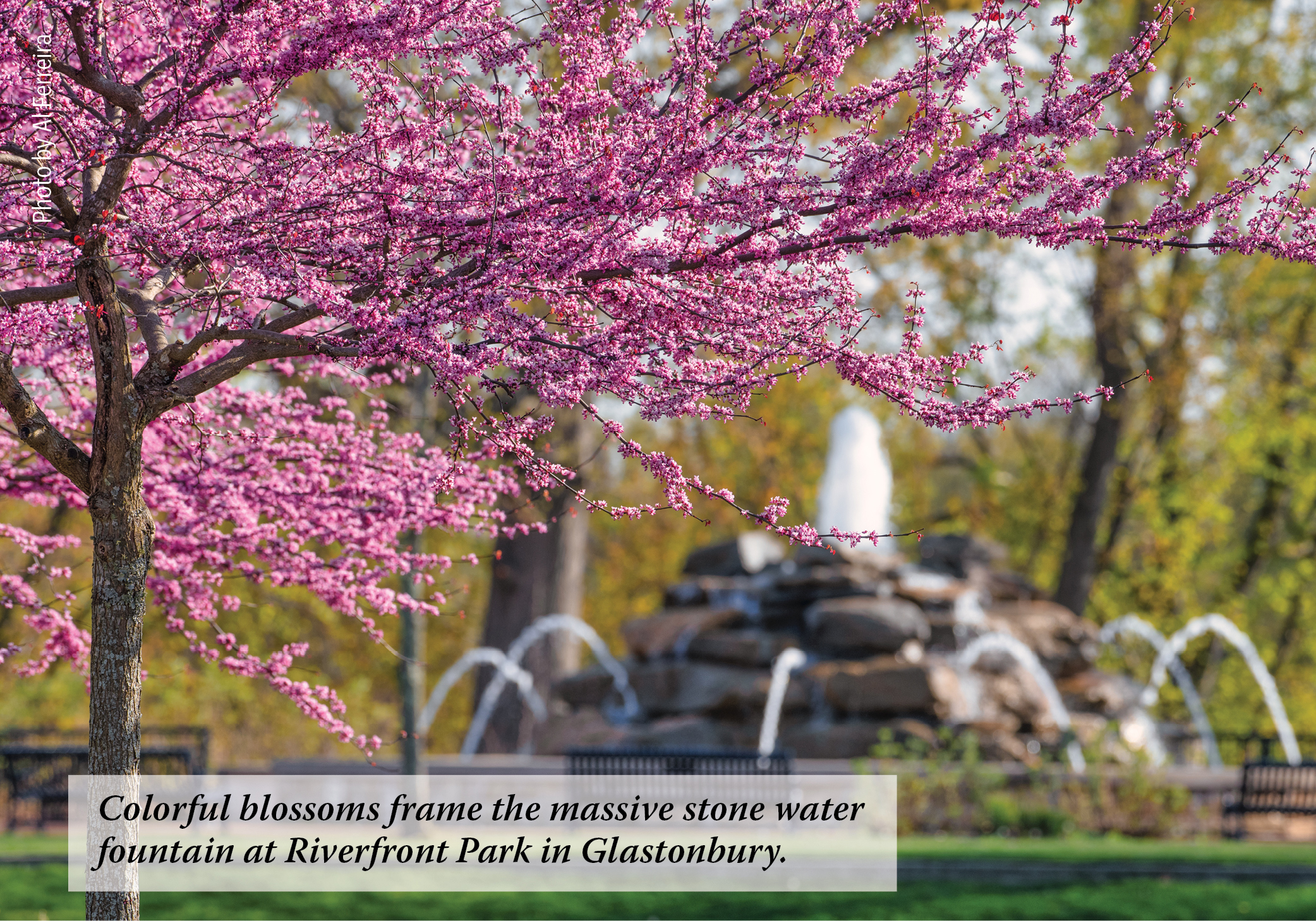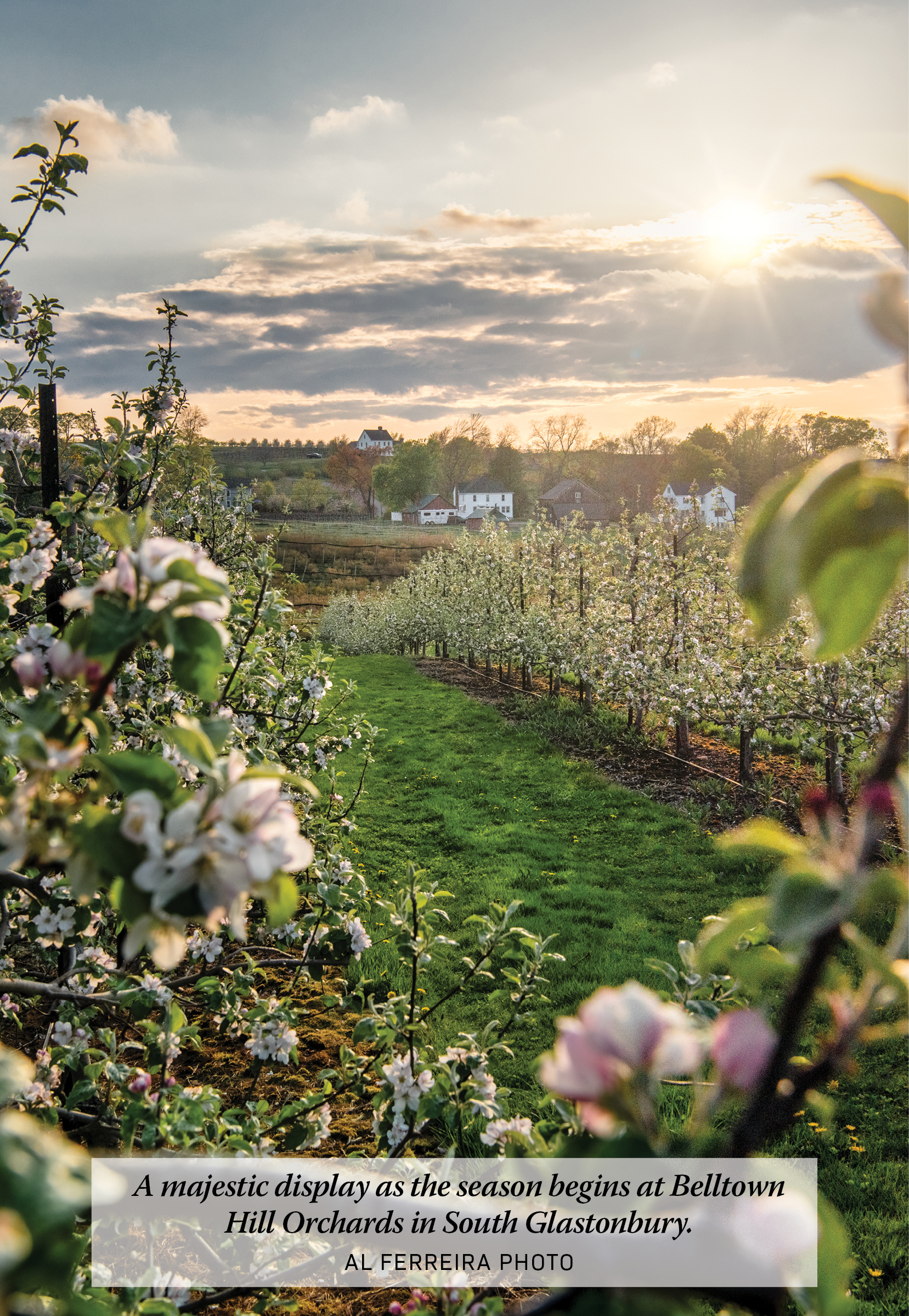Town
Site - Public Schools
- Welles-Turner Memorial Library
South Glastonbury Public Library - East Glastonbury Public Library

When most Nutmeggers hear the name Glastonbury, the word historic comes to mind — but never the word staid, for while this uniquely diverse town set just across the river from Connecticut’s capital city enjoys a rich history, it also has a reputation for providing residents and visitors alike a wealth of delights and diversions.
Established as Naubuc Farms in 1636, those first settlers swiftly became a steady stream of homesteaders — and the settlement, along with a fascinating narrative, began to sprout right along with the crops. Fifty-seven years later the town was officially founded and named after the beautiful village of Glastonbury in Somerset, England, though it took a couple of hundred years for the spellings to align. Known as Glassenbury until 1785 and Glastenbury after that, Glastonbury did not become Glastonbury until 1870. And the name wasn’t the only facet of the town that continued to change.
During the American Revolution, Yale University held classes here. Noah Webster once taught in a one-room schoolhouse here. And Abraham Lincoln’s secretary of the Navy, Gideon Welles, was born here.
Glastonbury was always known for its independent thinkers, opening a hospital to treat smallpox soon after the Revolution, freeing its slaves in the 1780s — a full 60 years before Connecticut legally abolished the practice, and establishing both a town library in 1803 and no less than ten schools before the century was out.
During the Revolutionary War, George Stocking’s gunpowder factory kept George Washington and his troops properly supplied, after which the town successfully transitioned into shipbuilding. The access and power derived from the Connecticut River’s local tributaries, as well as the wood harvested from the local forests, brought an increase in business activities, including the sawmills, charcoal kilns, and forges needed at the three Glastonbury shipyards that built and launched a total of 273 ships before the industrial revolution got underway — and when it did, Glastonbury didn’t miss a beat. The town welcomed the J.B. Williams Soap Factory, which is thought to have been the world’s first commercial soap manufacturing company, as well as the company known nationally for Aqua Velva and Lectric Shave.
Not to be outdone by their forefathers, Glastonbury businesses spent the 20th century’s two world wars supplying leather and woolen goods not only to America’s military but to the soldiers fighting for Great Britain, France, and Belgium. The first airplane factory in Connecticut was right here in Glastonbury. The town is still the eastern destination for the Connecticut River’s oldest continuously operating ferry. And Hartford’s Wadsworth Atheneum was built using stone from the town’s quarry. But not all of Glastonbury’s history is as conventional.
As early as the early 19th century, Glastonbury was home to the Smith Sisters, who spent their lives jostling the status quo by challenging what were, at the time, “the very narrow definitions of democracy that excluded women, blacks, and immigrants from full citizenship” by supporting the abolition of slavery, the education of women, and a woman’s right to vote.
More recently, Glastonbury was home to another independent-thinking woman named Laura Ingraham. Following her graduation from Dartmouth College and Virginia University Law School, she clerked at the Supreme Court before becoming a speechwriter for Ronald Reagan. She is now host of her own television show, as well as author of several New York Times best sellers.
A patch of Glastonbury land known as “the Hollister parcel” is thought to be an ancient Indian burial ground. There are a few places in town reputed to be haunted (but we won’t go there — literally or figuratively). And a mystery creature known as The Glawackus is said to have terrorized Glastonbury residents in the late 1930s, when it was thought to be attacking local livestock and pets. Described as part dog, part bear, and part cat, it was never caught, but some pretty thrilling expeditions were mounted in an ongoing effort to track it down.
And now, nearly four centuries on, Glastonbury continues to be not only historic and colorful but uniquely dynamic — the kind of place perfect for a good 21st century business, restaurant, or retail shop — and the kind of place families, professionals, singles, and retired couples love to call home.
Over the past decade, upscale dining spots from Hartford, West Hartford, and the Farmington Valley, including Bricco Trattoria, Max Fish, Luna Pizza, Plan B, First & Last Tavern and Bin 228 Gastropub, took notice of Glastonbury’s increasing popularity and swiftly began expanding to east-of-the-river locations, where they were welcomed by crowds pleased to have new choices so close at hand. That, in turn, prompted high-end retail operations to follow suit — with new homebuilders close on their heels. Schools flourished academically, while their athletes began winning their way to the top statewide in one sport after another. And soon, confident that Glastonbury had truly become a prime destination for businesses, restaurants, and shops, along with a steady increase in residents anxious to frequent them, the town began planning for a very bright future that is now in full swing.
Riverfront Park, an expansive development along the eastern bank of the Connecticut River, has quickly become a favorite spot for all sorts of family activities, as well as corporate meetings, non-profit events, and private parties, such as weddings, birthdays, and reunions. Its attractions include a boathouse with a public boat/crew/canoe/kayak launch and a dock for the Fire Department’s rescue boat; a picnic pavilion and a banquet facility; a playground for the youngsters and a lighted basketball court for kids of all ages; an outdoor ice skating area; and multi-use trails with scenic overlooks.
Now, all eyes are on town’s center, where additional development has been managed both creatively and wisely. The Roundabout Project, intended to ease the flow of increased traffic, is finished. New streetscape enhancements are making Glastonbury’s thriving commercial areas both more attractive and less harried for those on foot or riding bikes. And The Tannery, with its 250 distinctive apartment residences, is now open, as is One Glastonbury Place, which offers 145 one-, two-, and three-bedroom
apartments and townhomes.
Of course, Glastonbury’s popularity is not entirely new. Comprising 52 square miles of diversely scenic countryside, Glastonbury is, quite simply, a wonderful place to come home to. Factor in a fine educational system and all the necessities of life, and it’s no wonder Glastonbury has long been a favorite for families — young and growing, older and settled.
Likewise, Glastonbury has long appealed to business people, thanks to its location between Boston and New York and directly across the river from Hartford, as well as its closeness to important interstate highways and Bradley International Airport — though never more so than now.
And Glastonbury’s historic past, both distinguished and distinct, continues to add a special charm to even the most ordinary of the town’s byways and buildings. Arbor Acres used to be home to one of the world’s largest poultry producers. It was at the Hale Farm in South Glastonbury that John Howard Hale developed the Hale Peach — an incredibly delicious peach hardy enough to tolerate New England’s harsh winters — thus becoming the town’s Peach King. The town’s long history of tobacco farming was highlighted most recently as the Glastonbury Historical Society undertook the preservation of an 1870s tobacco shed for use as the Society’s museum. As noted, Aqua Velva and Lectric Shave were created and produced here at the J.B. Williams Soap Factory — now the Soap Factory Condominiums. And Glastonbury also has the distinction of having its own weekly newspaper, The Glastonbury Citizen, which has not only been covering local happenings for more than 50 years but is currently the only family-owned weekly in Connecticut.
Originally consisting of Glastonbury Center, South Glastonbury, and East Glastonbury, the town’s three hubs of activity continue to reflect those historic roots.

Glastonbury Center
Entering Glastonbury from Wethersfield via Route 3, The Shops at Somerset Square on Glastonbury Boulevard serve as a gateway that is both sophisticated and contemporary. Featuring classically inspired architecture designed in the 1980s by Robert A. M. Stern, who is now Dean of the Yale School of Architecture, Somerset Square comprises nearly half a million square feet of upscale retail space in a traditional town-square setting for easier access to its trendy shops, boutiques, and restaurants. Adjacent to The Square is the Hilton Garden Inn — which opened in 2004 as the town’s first hotel, and next door to that is the Hilton’s 135-unit Homewood Suites, a residential-style hotel for extended-stay travelers.
Heading east on Main Street reveals a mixed commercial thoroughfare, highlighted by Katz’s Ace Hardware, a veritable town landmark, which was founded in 1920 and is now on its third generation of family ownership. Then it’s on into Glastonbury Center itself.
Anchored by the stately Welles-Turner Library, with its tree-shaded park and fountain, the Center literally bustles with dozens of businesses and retail shops all located in four plazas along Hebron Avenue and Welles Street. And featuring a wonderful mix of new and established dining spots, Glastonbury Center has become a popular alternative to downtown Hartford or West Hartford Center for those on the hunt for a great meal. There’s a restaurant for everyone, from white linen haute-cuisine to the more casual pizza, deli, and take-out spots that make dinner as easy as it is tasty. (For complete listings, check out our Dining section on page 18.)
And there’s no need to leave town for a stylish new outfit, gear for the kids, jewelry, shoes, books, gifts, eyeglasses, floral arrangements, home décor, gourmet cooking accoutrements, and pet supplies. They’re all here, tucked in and around restaurants, and they all welcome browsers or buyers — though one often leads to the other. (A quick peek at Shopping on page 46 will get you started.)
Reminders of the town’s agricultural history are everywhere, as farms abound. Most have stands and shops brimming with fresh veggies and fruits and flowers in season, but you’ll also find the CSA farms that make owning a tiny piece of their seasonal harvest possible. (We have a whole section for Glastonbury Farms on page 26. Take a look.)
Main Street south of the Center marks the start of the Historic District, where handsome 18th and 19th century homes built by some of the town’s most prominent early families line the streets. On the corner of Hubbard Street, in what was originally the Town Hall, is the Glastonbury Historical Society, which features exhibits designed to celebrate the town’s Native American, agricultural, and industrial heritage. Behind it, the original Town Green is home to the Art Guild’s annual art shows and the town’s Concerts on the Green. And adjacent to the Town Green is Green Cemetery with headstones dating back to the 1600s.

South Glastonbury
Two miles south, Main Street merges with Route 17 on its way to South Glastonbury village. Along the way is The Old Cider Mill, one of the country’s oldest mills, open only in the fall. Glastonbury residents and out-of-towners alike flock there as soon as there’s a hint of autumn in the air for Riverview Farm’s Fall Festival with its selection of local fruits, vegetables, cider, and the tastiest apple fritters anywhere — plus they have a great little petting zoo. And there are plenty of local growers open all season for real farm-to-table convenience. (Again, a visit to page 26’s Glastonbury Farms listings will provide you with a complete list of local growers and CSA opportunities.)
Just before reaching the town’s village center, you’ll find the Welles-Shipman-Ward House. Built in 1755, it “possesses exceptional architecture,” according to the U.S. Department of the Interior. Now owned by the Historical Society, the house, as well as its 18th-century-style herb gardens and vintage barns, are open to visitors. And once in the village, a mix of historic and contemporary buildings with sidewalks that make any of its attractions easily accessible ensures that South Glastonbury is the perfect pedestrian village. Among the popular spots are three historic churches and plenty of places to go if you get hungry.
Behind South Tavern, just above the village, is Cotton Hollow Preserve — a hiker’s delight, with paths winding along Roaring Brook to the impressive ruins of what was once a vibrant 18th and 19th century industrial community. Waterfalls with pools of cool, sparkling water often draw a skinny-dipper or two on a hot summer’s day.
And from Main Street, a right on Water Street leads west on a scenic road toward the Glastonbury-Rocky Hill Ferry landing and the Seaboard Marina on the Connecticut River, home of the Glastonbury High School rowing team. Along the way, Glastonbury’s horsey set struts its stuff — and its stallions. The lovely meadowlands provide a perfect setting for expansive equestrian centers like The Pines on Dug Road. The Horton Farm, still a family operation, is another landmark.
East Glastonbury
Heading east out of the village, Hopewell Road wends it’s way upward through the hills to Chestnut Hill Road and on into East Glastonbury, where several spots offer a breathtaking view of the Connecticut River. Upon reaching New London Turnpike, Chestnut Hill Commons appears. Featuring The Country Store, which happily advertises live bait, crawlers, and worms among its other wares, The Commons adds a nice touch of everyday convenience to this uniquely scenic area. And so does the plaza you’ll reach if you take Quarry Road — then a left on Manchester Road to Hebron Avenue. Just a decade ago, that crossroads offered little more than a gas station and the historic Buckingham Congregational Church. Today, there’s a plaza anchored by Highland Park Market, the famous gourmet food emporium that originated in Manchester.
While continued development is inevitable, residents have never been shy about saying when enough is enough — and the “powers that be” listen. The Town Center plan has been shaped by considerable citizen input. And South Glastonbury’s river meadows farmland has, thus far, resisted persistent attempts at housing development.
Good thing, too, because there’s an old tale about a goose prized for laying golden eggs. And if truth be told, Glastonbury’s beguiling riverbanks, quiet streams, shaded woodlands, vast farms and fields, hillsides dotted with orchards, and streets lined with a unique blend of historic homes, small businesses, sidewalk cafés, and chic little shops are golden eggs, one and all — and worthy of astute preservation.
Photography by Al Ferreira |